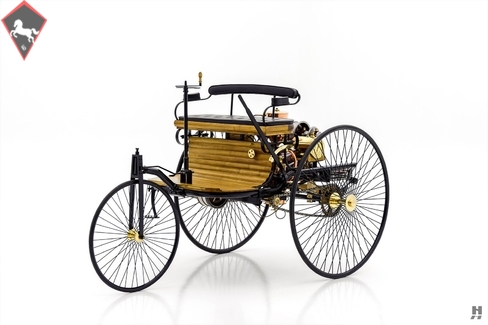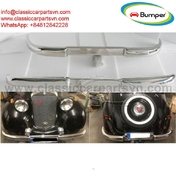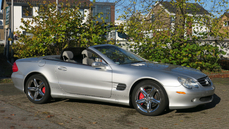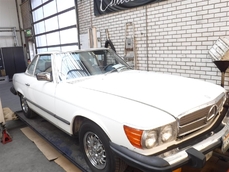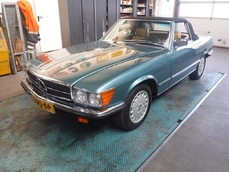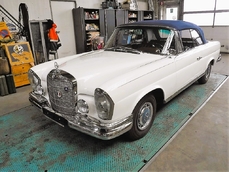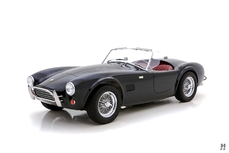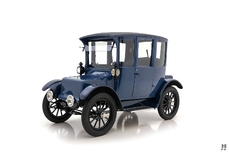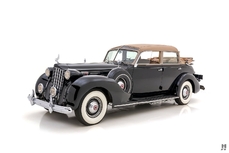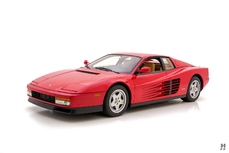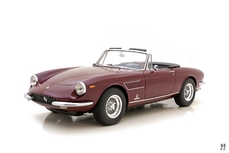Mercedes-Benz Other Wagon 1901
General description :
If there is one vehicle that could be considered the genesis of the modern automobile, it is Karl Benz’s revolutionary Patent Motorwagen of 1886. To truly pinpoint the first automobile may be an impossible task, but it was the Benz that made the first successful and public long-distance drive and the first to successfully reach production. It stands as one of the most significant inventions of the 19th century and is included in the United Nations Educational, Scientific and Cultural Organization (UNESCO) International Documentary Heritage Register.
Benz’s creation was true to form of similar early motorcars, in that it featured a small capacity engine in a buggy-style chassis. The Benz used a single cylinder, horizontally placed four-stroke engine of 954 cubic centimeters. Spinning at a rather low 400 rpm (Benz favored low-revving engines as he believed higher speeds would cause failures), the petrol powered engine produced about 0.75 horsepower and could move the 265kg machine along at about eight mph in ideal conditions. Power transmission was via a large flat belt, with final drive handled by a pair of robust chains driving the large spoked wheels. The engine was cooled via an evaporative water system, which meant regular stops to refill the reservoir. Engine speed was controlled via a sleeve valve below the seat and braking via hand lever connected to the belt-pulley system. The chassis rode on elliptic springs in the rear (as well as on the buggy-style seat), and a single front wheel was steered via tiller as Benz was not yet aware of the Ackermann geometry system that allowed for two steering wheels on a front axle.
Simple yet effective, the Patent Motorwagen had a rather quiet launch as Karl Benz was continually tinkering with the design before presenting it to the press and potential buyers. His business partners grew increasingly impatient, as did his wife, Bertha Benz, who had also supplied Karl with a significant source of funds for his project. Perhaps motivated to help her husband or probably out of sheer impatience for his perfectionism, Bertha took her two teenage sons in Patent Motorwagen #3 on the world’s first long-distance motoring journey – and without informing her husband. She traveled from their home in Mannheim to Pforzheim, a one-way distance of about 66 miles (106 km). Along the way, Bertha cleared a clogged fuel line with a hat pin and used her garter as insulation material on a frayed wire. When the brakes were found to be inadequate, she had a cobbler fashion some leather into the first ever brake pad. She stopped at a pharmacy in Wiesloch to purchase ligroin (a petroleum solvent) and thereby created the world’s first filling station! Her teenage sons often had to push the machine up steep inclines, but the journey was completed by dusk, with Bertha notifying Karl of her arrival in Pforzheim via telegram. She would make a successful return trip a few days later. The importance of Bertha’s drive in the Patent Motorwagen cannot be overstated – her experiences on the journey influenced the design of the production models and future Benz machines. She was, in essence, the world’s first development driver for a tiny firm that would eventually grow into one of the world’s premier vehicle manufacturers – Mercedes-Benz.
In 1986, to celebrate the machine’s 100th anniversary and to honor the achievements of Karl and Bertha Benz, Daimler-Benz commissioned a series of functional replicas of the Benz Patent-Motorwagen, which were to be sold directly through the Mercedes-Benz Classic Center in Germany. Mercedes outsourced the task of producing the model to the highly capable John Bentley and Sons Engineering in England, who used Daimler-Benz’s authentic example as a pattern to build a near-perfect, running and driving recreation. Since 1986 approximately 330 have been constructed by Mr. Bentley, and his creations are considered the most desirable and authentic.
Our featured 1886 Patent Motorwagen is a brand new build direct from John Bentley, wearing unit number MH040418. It is meticulously handcrafted using original-type materials and detailed to a very high standard. The finish work and quality of the machining are impressive; from the simple, exposed mechanicals to the finely fitted wood decking and hand-stitched black leather buggy seat. It rides on lightweight metal spoke wire wheels built on beautiful brass hubs as original (Benz felt wood was far too heavy and cumbersome). The single-cylinder engine is an exquisite display in itself; a mix of highly polished copper, brass, and deep red-painted cast iron. It is correctly detailed down to the thick leather belt that transmits power from the engine to the final drive chains. It is no mere static display, as it runs and drives in the same manner as the original.
The quality and craftsmanship are impressive throughout, and this delightful piece would be a welcome addition to virtually any collection or transportation museum. While it may appear on the surface to be little more than a full-scale collectible model; it is, in fact, a fully functioning and incredibly faithful recreation. The Benz Patent Motorwagen stands proudly as the father of the internal-combustion motorcar, and we are pleased to offer this outstanding tribute in celebration of the groundbreaking original.
https://hymanltd.com/vehicles/6202
1901 Mercedes-Benz Other Wagon is listed sold on ClassicDigest in St. Louis by Mark Hyman for $59500.
Car Facts
Car type : Car Make : Mercedes-Benz Model : Other Model Version : Wagon Engine size : 0.0 Model Year : 1901 Location : Missouri
Sold
Seller Information
Sold
People who viewed this Mercedes-Benz Other also viewed similar Mercedes-Benz listed at ClassicDigest
Other cars listed for sale by this dealer
About Mercedes-Benz
In the annals of automotive history, the journey of Mercedes-Benz is a tale that unfolds with the ingenuity of its founding pioneers. In the year 1886, Karl Benz crafted the Benz Patent Motorwagen, a creation that would go down in history as the world's inaugural automobile. Unbeknownst to him, this moment marked the genesis of what would evolve into the most illustrious premium car manufacturer globally. The financial underpinning of this pioneering venture, interestingly, was provided by Karl Benz's wife, Bertha Benz, demonstrating a remarkable partnership that would set the tone for Mercedes-Benz's legacy.A parallel narrative emerged not far away, as Daimler-Motoren-Gesellschaft, founded by Gottlieb Daimler and Wilhelm Maybach, entered the scene. In 1901, they unveiled their automobile under the now-famous moniker "Mercedes," meaning "godsend" in Spanish. This name was bestowed upon the car at the behest of Emil Jellinek's daughter, the distributor for Daimler-Motoren-Gesellschaft. The wheels of innovation were set in motion.
Fast forward to 1926, a pivotal year that witnessed the merger of Daimler with Benz & Cie., culminating in the birth of Daimler-Benz. The amalgamation saw the adoption of "Mercedes-Benz" as the distinguished trademark for their automobiles, fusing the legacies of two visionary entities into one.
Contrary to perceptions of conservatism, the trajectory of Daimler-Benz unfolds as a chronicle of industry firsts. From the introduction of the honeycomb radiator to the float carburetor, and the pioneering implementation of four-wheel brakes in 1924, Daimler-Benz consistently pushed the boundaries of automotive innovation. The diesel-powered Mercedes-Benz 260 D in 1936 marked the inception of diesel engines in passenger cars. The iconic Mercedes-Benz 300SL Gullwing made history as the first car with direct fuel injection, albeit the Gutbrod's tiny 2-stroke engine can claim precedence.
Safety innovations became a hallmark, with Béla Barényi's patented safety cell design in the "Ponton"-models in 1951, featuring front and rear crumple zones. The W116 450SEL 6.9 saw the introduction of the Anti-Lock Brake system (ABS), another pioneering safety feature. From the first production airbags and beyond, the legacy of "firsts" continued to be etched into the fabric of Daimler-Benz.
Over its centennial journey, Mercedes-Benz has not merely produced cars but has sculpted automotive icons. The SSKL, 710 SSK Trossi Roadster, 770K Grosser, 540K Spezial Roadster, 300SL Gullwing, w100 600 Pullman, w111 280SE 3.5 Flachkühler, w113 230SL Pagoda, w109 300 SEL 6.3, and w201 2.3-16 Cosworth stand testament to the brand's commitment to engineering excellence.
The roaring Silver Arrows, or "Silberpfeile," including the W 25, W 125, W154, W165, and W196, created a legacy of dominance on the racetrack. These machines were not merely cars; they were expressions of precision, speed, and an indomitable spirit that left their competitors in the dust.
As Mercedes-Benz marches into the future, it does so not just as an automaker but as a custodian of a legacy, a torchbearer of innovation, and a beacon of automotive excellence. The road ahead is sure to witness the continued fusion of cutting-edge technology, timeless design, and an unwavering commitment to setting new standards in the world of automobiles.
One luminary figure who left an indelible mark was Béla Barényi, often heralded as the "father of passive safety" for his pioneering work in safety engineering. His patented safety cell design, featuring front and rear crumple zones, became a hallmark of Mercedes-Benz's commitment to occupant safety, setting new standards that reverberated throughout the automotive world.
Moving through the chronicles, the collaborative genius of Wilhelm Maybach, alongside Gottlieb Daimler, laid the foundation for Daimler-Motoren-Gesellschaft. Their innovations not only birthed the first Mercedes but established a culture of relentless pursuit of technological excellence that remains integral to Mercedes-Benz's DNA.
In the post-merger era of 1926, Ferdinand Porsche emerged as a prominent figure within Mercedes-Benz. His work on the Mercedes-Benz S-Type, a supercharged race car, garnered acclaim and set the stage for a legacy that extended far beyond the marque. Porsche's impact would later extend to his eponymous company, but his influence at Mercedes-Benz during those formative years was pivotal.
As the 20th century progressed, the legendary Rudolf Uhlenhaut emerged as a key figure. Uhlenhaut, an accomplished engineer and the driving force behind the iconic Silver Arrows, played a crucial role in Mercedes-Benz's dominance in motorsports. His engineering prowess and attention to detail were instrumental in creating some of the most formidable racing cars of the era.
In the latter half of the century, figures like Bruno Sacco, the head of design at Mercedes-Benz from 1975 to 1999, left an indelible imprint on the brand's aesthetic identity. Sacco's design philosophy, characterized by clean lines and timeless elegance, shaped iconic models like the W126 S-Class and the W201 190E, solidifying Mercedes-Benz's reputation for luxury and sophistication.
The narrative would be incomplete without acknowledging the contributions of engineers like Hans Scherenberg, whose leadership in the 1970s ushered in a new era of technological innovation at Mercedes-Benz. Scherenberg's tenure saw the development of groundbreaking technologies, including the Anti-Lock Brake system (ABS) and the introduction of airbags in production cars.
